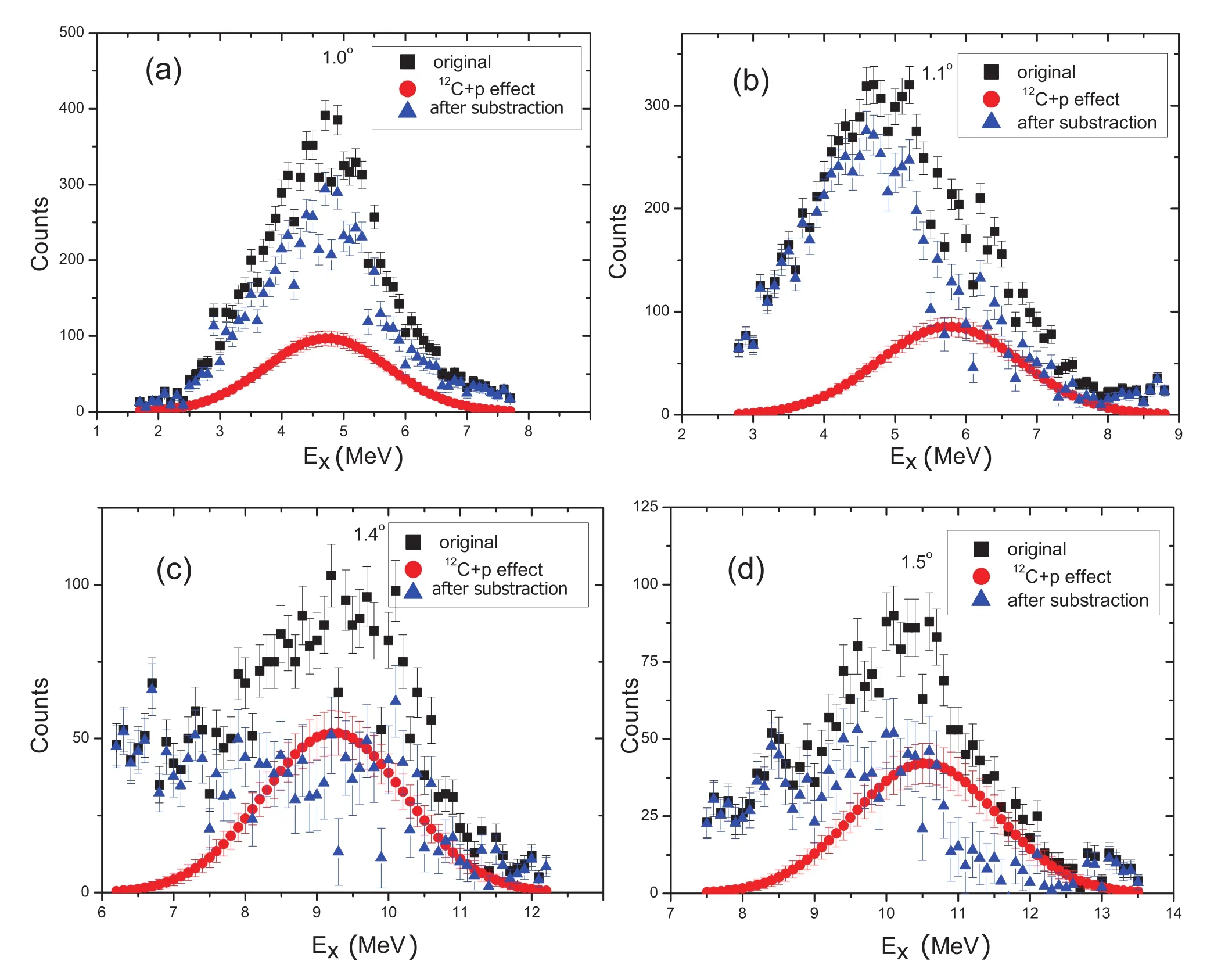A method of estimating and subtracting the hydrogen background in the natural carbon target used in the12C+12C experiment∗
2014-08-05QUWeiWei屈卫卫ZHANGGaoLong张高龙SatoruTerashimaIsaoTanihata3GUOChenLei郭晨雷andLEXiaoYun乐小云
QU Wei-Wei(屈卫卫),ZHANG Gao-Long(张高龙),,Satoru Terashima,Isao Tanihata,,3GUO Chen-Lei(郭晨雷),and LE Xiao-Yun(乐小云)
1School of Physics and Nuclear Energy Engineering,Beihang University,Beijing 100191,China
2International Research Center for Nuclei and Particles in the Cosmos,Beihang University,Beijing 100191,China
3Research Center for Nuclear Physics,Osaka University,Osaka 567-0047,Japan
A method of estimating and subtracting the hydrogen background in the natural carbon target used in the12C+12C experiment∗
QU Wei-Wei(屈卫卫),1,2ZHANG Gao-Long(张高龙),1,2,†Satoru Terashima,1,2Isao Tanihata,1,2,3GUO Chen-Lei(郭晨雷),1,2and LE Xiao-Yun(乐小云)1,2
1School of Physics and Nuclear Energy Engineering,Beihang University,Beijing 100191,China
2International Research Center for Nuclei and Particles in the Cosmos,Beihang University,Beijing 100191,China
3Research Center for Nuclear Physics,Osaka University,Osaka 567-0047,Japan
The experimental data of 100AMeV12C+12C elastic scattering are checked by using two-body kinematic calculation and12C+p elastic scattering.It is shown that the measured data are true and reliable.In the paper, the transformation between the excited energy spectra of the12C+12C system and the ground state energy spectra of the12C+p system is introduced.The method of subtraction of the hydrogen background in the natural carbon target used in the experiment is elaborately described and the results are discussed.It is indicated that this method of subtraction of hydrogen background is reasonable and can be used in the data analysis.Based on the elastic scattering cross section of the previous experiment of12C+p at 95.3AMeV,the hydrogen content entered into the reaction is analyzed.The final hydrogen content in the natural carbon target is(2.73±0.12)%.
Elastic scattering,Subtraction background,Hydrogen content
I.INTRODUCTION
The role of the three-body-force(TBF)in complex nuclear systems is one of the key issues not only in nuclear physics but also in nuclear astrophysics relevant to high-density nuclear matter,such as neutron stars and supernova explosions. In nuclear collisions,elastic scattering can provide important information on the nucleon-nucleon(NN)and nucleusnucleus(AA)interaction.Recently in Ref.[1–7]a double folding model(DFM)with a new type of complex G-matrix interaction including the TBF,was developed.They applied it to calculate the optical potential of 100A–400AMeV12C+12C elastic scattering.It was indicated that the real part of the optical potential changes its character from attraction to repulsion as the incident energy increases.The angular distribution of12C+12C elastic scattering shows a different diffraction transition with and without the TBF effect.Through this evolution of optical potential and angular distribution of elastic scattering with an increase of incident energies,the contributions of TBF and tensor force can be extracted[5].However,so far there are not many theoretical and experimental studies for heavy ions at higher energies than those of deuteron[8].Therefore,the angular distribution of12C on12C elastic scattering needs to be experimentally measured in the incident energy range of 100A–400AMeV. Through the precise measurement of elastic scattering,the repulsive nature of optical potential can be explained and the transition energy from attraction to repulsion of the real part in optical potential can be determined.It can provide important information about the TBF effect,the medium effect ofhigh density nuclear matter,the energy dependence of TBF, and the role of tensor force.
II.EXPERIMENTAL SECTION
Firstly,the 100AMeV12C+12C experiment was performed in Research Center for Nuclear Physics(RCNP)at Osaka University.The angular distribution was precisely obtained using the magnetic spectrometer,“Grand Raiden”. This magnetic spectrometer has excellent ion-optical properties[9].In order to make full use of the magnetic spectrometer,the beam was transported under the achromatic focusing along the WS beamline[10].During the experiment we used a 1.181mg/cm2-thickness natural carbon target and a 11.40mg/cm2-thickness(CH2)ntarget.TheTOF-ΔEsignals, which were obtained from focal plane detectors,were used for particle identification.The details of focal plane detectors are described in Ref.[11].After particle identification,the two dimensional plots of outgoing12C particle excitation energies with laboratory angles were obtained when the central angle of the magnetic spectrometer was set to 2.0◦,as shown in Fig.1.We can clearly observe three horizontal bands which correspond to the ground state,4.44MeV(2+)and 9.65MeV(3−)excited state of12C+12C scattering.However,another tilted band crossing with the horizontal bands exists in Fig.1.It increases the number of12C+12C scattering events,especially at small angles.The contribution of this part cannot be neglected.In comparison with those from the excited states of12C on12C scattering,it is much larger at the smaller angles.So if the contribution of the tilted band is not subtracted,the differential cross section of12C on12C scattering can be affected.In the paper,we introduce a method to subtract this disturbance and obtain the content on the experimental target.

Fig.1.(Color online)The two dimensional plot of outgoing12C particles excitation energies with laboratory angles when the central angle of the magnetic spectrometer was set to 2.0◦for 100AMeV12C+12C scattering.
III.RESULTS AND DISCUSSION
Firstly,we compared the results of Fig.1 on the natural target with that on the(CH2)ntarget.The results are similar. Moreover,there was no tilted band in other plots on the natural carbon target at larger angles.So it is concluded that the tilted band is from12C on hydrogen scattering.Second,we checked the experimental data on the basis of the relativistic kinematics calculation.For reactionA(a,b)B,a,A,b,andBrepresent the projectile,the target nucleus,the scattered particle,and the recoiled nucleus,respectively.According to the definition ofQ(reaction energy),

whereKa,KA,Kb,andKBdenote the kinetic energies of the projectile,the target,the scattered particles,and the recoiled particles,respectively.Here,KA=0.According to the momentum conservation

wherepa,pb,andpB,respectively represent the momentum of the projectile,the scattered nucleus,and the recoiled nucleus.θis the scattering angle in the laboratory frame.If the relativistic is considered,the relationship between momentum and kinetic energy can be obtained

wheremidenotes the rest mass of nuclei.i=a,A,b, andBrepresent the projectile,the target nucleus,the scattered nucleus,and the recoiled nucleus,respectively.From Eqs.(1),(2),and(3),it can be obtained

where

Through Eq.(4),for the ground state of12C+p and the excited states of12C+12C at 100AMeV incident energy,it is shown that the first excited state 4.4MeV(2+1)of12C+12C scattering and the ground state of12C+p cross at 1.015◦. The 9.64MeV(3−1)state of12C+12C and the ground state of12C+p cross at 1.5◦.The influence of the beam uncertainty(including the beam angular and beam size shift,which is about 2%)can be neglected for the calculation of cross angles.From Fig.1,we can clearly see that the crossing angles are about 1.0◦and 1.5◦,which are consistent with the calculation.It proves the authenticity of the experimental data.
A.Subtraction of hydrogen disturbance in target
For easy selection of12C+p events,we convert the energy spectrum of12C+12C,shown in Fig.1 to that of12C+p system,which is shown in Fig.2.

Fig.2.(Color online)The two dimensional plot of outgoing12C particle excitation energies with laboratory angles of12C+p elastic scattering at 100AMeV.
During the conversion we used a polynomial function to rotate it.The rotation has to obey the rules.The excitation energy cannot change with the angles and the excitation energy of the ground state must stay zero.Finally we get the Eq.(6):

whereQ′andQrepresent the outgoing12C excitation energies of the12C+p and12C+12C systems,respectively. The uncrossed region of 1.7◦–2.2◦is selected,as it is mainly caused by12C+p elastic scattering.Fig.3 shows the outgoing12C excitation energy spectrum at 1.8◦and the fitting results.This method was applied to the other angles,we can obtain the real number of reactions with hydrogen and the widthσof the Gaussian distribution.

Fig.3.The selection of the excitation energy spectrum at 1.8◦in the uncrossed region of Fig.2 and the fitting results.The square points and the solid line denote the experimental data and the fitting results, respectively.

Fig.4.The angular distribution of 95.3AMeV12C+p elastic scattering in laboratory system.
The differential cross sections of 96MeV p+12C elastic scattering in Ref.[12]in the center of mass frame was converted to that of12C+p elastic scattering in the laboratory frame with the incident energy 95.3AMeV as shown in Fig.4.In order to obtain the relationship between the angles and the differential cross sections,the experimental data were fitted from 0.8◦to 2.2◦.Then we used the fitting function to calculate the differential cross sections from 1.7◦to 2.2◦,and obtained the ratios between the differential cross sections and the real counts at each angle.The least square method was used to optimize all the ratios.As a result,an optimized ratio,the normalization factor,was given.We then checked the reliability of the normalization factor through the comparison between the normalized counts and real counts,as shown in Fig.5.It is obvious that all of values are in the range of error bars.So the obtained normalization factor is reasonable.We also checked the results of the uncrossed region of 1.7◦–2.2◦after the subtraction of the background by using this normalization factor.Fig.6 shows the result at 1.8◦.It is shown that the peak can be subtracted within statistical fluctuation.After that,only the background is left.Therefore,this method for the subtraction of the hydrogen disturbance is reasonable.

Fig.5.(Color online)The comparison between the normalized counts(circle)and real counts(square).

Fig.6.(Color online)The test of the subtraction of hydrogen disturbance at 1.8◦.The original data(square),the effect of12C+p elastic scattering(circle)and the result after subtraction(triangle).
Weappliedthismethodforthecrossedregionof0.9◦–1.6◦. The above normalization factor is used to calculate the real counts at the crossed regions of 0.9◦–1.6◦,along with the data from12C+p elastic scattering.These deduced counts are acted as the Gaussian distribution in the excitation energy spectra of the12C+12C system.The values of the center and the width of the fitted Gaussian distribution in Fig.3 were transformed to those of12C+12C system by using Eq.(6). So the values of the width and the center of the Gaussian dis-tribution in the12C+12C system are determined.The width is usually set as 3σ.The results of four examples are shown in Fig.7.It’s obvious that the12C+p elastic scattering contribution is large in comparison with that of12C+12C in Fig.7(c).

Fig.7.(Color online)The results of hydrogen subtraction at 1.0◦,1.1◦,1.4◦and 1.5◦.
B.Extraction of hydrogen content in the natural carbon target
The differential cross section is defined as

whereN,εd,εt,N0,NT,and dΩdenote the counts of reaction events,the detectors efficiencies,the trigger efficiency, the beam intensity,the target number per square centimeter, and the solid angle,respectively.Since we obtained the reacted counts from12C+p elastic scattering in the uncrossed region of the fitting in Fig.3 and the differential cross sec-tions are given from Fig.4,εd,εt,N0,and dΩcan be determined according to the experimental arrangement and measurement.Then we can obtain the hydrogen content for each angle.The results are listed in Table 1.Using the weightedmean method,the final hydrogen content in the natural carbon target is(2.73±0.12)%.

TABLE 1.The results of hydrogen content in the natural carbon target.The first and the second columns represent the angles in the laboratory frame and the real counts of reacted hydrogen deduced from the fitting,respectively.The third column shows the amount of hydrogen per area of the natural carbon target.The relative error of hydrogen content is indicated in fourth column
IV.CONCLUSION
In this paper,we used two-body kinematics to calculate the cross angles of the ground state of 95.3AMeV12C+p elastic scattering and the excited states of 100AMeV12C+12C,including the 4.4MeV(2+1)state and the 9.64MeV(3−1)state. By using this method,the experimental angles are calibrated and the experimental data are checked.Next,the method and the results of the subtraction of hydrogen contaminant are introduced and discussed,respectively.The elastic scattering of12Conhydrogenbackgroundfromtheexperimentaltargethas a large contribution at some angles,so in the data analysis the contribution of this part needs to be subtracted.Finally,the hydrogen content in the natural carbon target was extracted. The result is(2.73±0.12)%.At the same time,the method used in present paper can help us improve the future experiment.The experiment using the(CH2)ntarget can calibrate some parameters,such as the efficiencies of the faraday cup, detectors,and so on.It provides a method for nuclear physics experiments.
ACKNOWLEDGMENTS
We thank Prof.Sakaguchi Harutaka from RCNP for his help during the preparation of the experiment.We are also grateful to the RCNP Ring Cyclotron staffs for providing the stable carbon beams throughout the experiment.
[1]Furumoto T and Sakuragi Y.Phys Rev C,2006,74:034606.
[2]Furumoto T,Sakuragi Y,Yamamoto Y.Phys Rev C,2008,78: 044610.
[3]Furumoto T,Sakuragi Y,Yamamoto Y.Phys Rev C,2009,79: 011601(R).
[4]Furumoto T,Sakuragi Y,Yamamoto Y.Phys Rev C,2009,80: 044614.
[5]Furumoto T,Sakuragi Y,Yamamoto Y.Phys Rev C,2010,82: 044612.
[6]Furumoto T,Horiuchi W,Takashina,et al.Phys Rev C,2012,85:044607.
[7]Furumoto T and Sakuragi Y.Phys Rev C,2013,87:014618.
[8]Nguyen V,Ye Y,Arvieux J,et al.Nucl Phys A,1987,464: 717–739.
[9]Fujiwara M,Akimune H,Daito I,et al.Nucl Instrum Meth A, 1999,422:484–488.
[10]Wakasa T,Hatanakaa K,Fujita Y,et al.Nucl Instrum Meth A, 2002,482:79–93.
[11]Qu W,Zhang G,Tanihata I,et al.Chinese Phys C,2014,38: 116202.
[12]Strauch K and Titus F.Phys Rev,1953,103:200–208.
10.13538/j.1001-8042/nst.25.050501
(Received March 3,2014;accepted in revised form May 1,2014;published online September 23,2014)
∗Supported by the Innovation Foundation of BUAA for PhD Graduates and National Natural Science Foundation of China(Nos.11035007,11235002 and 11175011)
†Corresponding author,zgl@buaa.edu.cn
杂志排行
Nuclear Science and Techniques的其它文章
- Dose rate distribution of photoneutrons in an ID beamline of SSRF:simulations and measurements
- Calibration method for electrode gains in an axially symmetric stripline BPM∗
- A study of quasi-absolute method in photon activation analysis∗
- High-resolution boosted reconstruction of γ-ray spectra∗
- A fractionation model based on three lognormal particle size distributions
- Model-predictive control of power supply for particle accelerators∗
